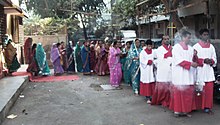
The Konkan is a stretch of land by the western coast of India, bound by the river Daman Ganga at Damaon in the north, to Anjediva Island next to Karwar town in the south; with the Arabian Sea to the west and the Deccan plateau to the east. The hinterland east of the coast has numerous river valleys, riverine islands and the hilly slopes known as the Western Ghats; that lead up into the tablelands of the Deccan. The region has been recognised by name, since at least the time of Strabo in the third century CE. It had a thriving mercantile port with Arab tradesmen from the 10th century. The best-known islands of Konkan are Ilhas de Goa, the site of the Goa state's capital at Panjim and the Seven Islands of Bombay, on which lies Mumbai, the capital of Maharashtra and the headquarters of Konkan Division.
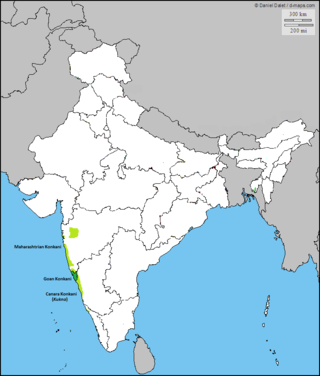
Konkani is an Indo-Aryan language spoken by the Konkani people, primarily in the Konkan region, along the western coast of India. It is one of the 22 scheduled languages mentioned in the Indian Constitution, and the official language of the Indian state of Goa. It is also spoken in Karnataka, Maharashtra, Kerala, Gujarat as well as Damaon, Diu & Silvassa.

The East Indians, also called East Indian Catholics or Bombay East Indians, are an ethno-religious Indian Christian community native to the Seven Islands of Bombay and the neighbouring Mumbai Metropolitan Area of the Konkan division.
The Konkani people are an Indo-Aryan ethnolinguistic group native to the Konkan region of the Indian subcontinent who speak various dialects of the Konkani language. Konkani is the state language of Goa and also spoken by populations in Karnataka, Maharashtra, Damaon and Kerala. Other Konkani speakers are found in Gujarat state. A large percentage of Konkani people are bilingual.
Norteiros were a historical people who lived in the former Portuguese exclaves in the western littoral parts of the northern Konkan region, in the present-day Greater Bombay Metropolitan Area and the federal territory of Damaon, Dio & Silvassa.

Sandor is a census town falling within the Vasai (Bassein) municipality of the Palghar district, in the Konkan division of Maharashtra, India. Sandoris, the natives of Sandor, are predominantly Roman Catholic Kshatriyas of the Christian Bombay East Indian community, they converted in the colony centred around Bassein, the richest possession of the former Portuguese East Indies with the capital at Velha Goa, in the southern edge of the Konkan region. Prior to the arrival of Portuguese Armadas, there had also been some Nestorians descended from Jewish converts, by the efforts of the apostles Thomas or Bartholomew.
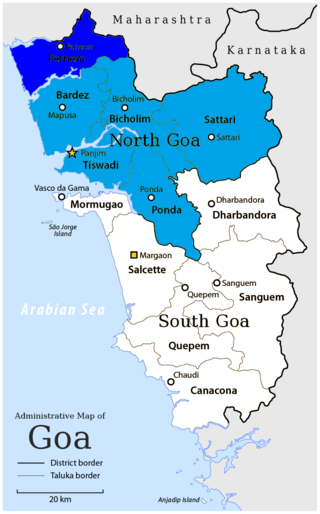
Pernem is a northmost administrative region or sub-district in North Goa in India. It acts as the Gateway of Goa from Maharashtra side. It is also the name of the town of Pernem, which is its headquarters. It has a Municipal Council. Geographically, Pernem is surrounded by Sawantwadi sub-district on East, Arabian Sea on West, Bardez and Bicholim sub-district on south and Sawantwadi sub-district on north. The two rivers which decide the boundary of this sub-district are Terekhol River and Chapora River. Terekhol river acts as a border of Maharashtra and Goa while Chapora river acts as a border of Pernem sub-district and Bardez sub-district.
Narayan Vaman Tilak was a Marathi poet from the Konkan region of then Bombay Presidency in British India, and a famous convert to Christianity from Chitpavan Brahmin Community.

The Konkan Division is one of the six administrative divisions of Maharashtra state in India. It comprises the central portions of the Konkani region excluding Goa and Damaon, which were absorbed into Maharashtra owing to the States Reorganisation of India. Konkan Division is the western section of present-day Maharashtra, along the west coast of India. The two districts of the state capital Mumbai also fall into this division.
Thomas Stephens was an English Jesuit priest and missionary in Portuguese India, writer and linguist of Marathi and Konkani.
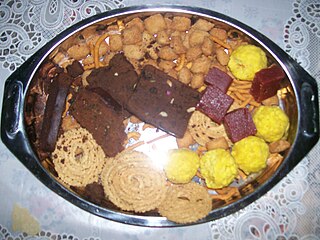
Kuswar or Kuswad is a set of festive sweets and snacks made and exchanged by Christians of the Konkan region in the Indian subcontinent for the Christmas season or Christmastide. These goodies are major parts of the cuisines of the Goan Catholic community of Goa in the Konkan region, and the Mangalorean Catholic community of Karnataka. There are as many as 22 different ethnic recipes that form this distinct flavour of Christmas celebration in Goa and Mangalore. Kuswad is also made and exchanged by Karwari Catholics of Carnataca and the Kudali Catholics of Sindhudurg, in the Konkan division of Maharashtra.

Koli Christians are subgroup of the Koli people, known as Bombay East Indians, the indigenous people of the Seven Islands of Bombay and the Bombay metro area, which is now also called Mumbai (Bombay). The Koli Christians were of the Son Koli caste, before their conversion by the Portuguese from Brahmanism to Christianity, in the former Bom Bahia of Portuguese India. Christian Kolis are also known as Thankar and Gaonkar Kolis in Maharashtra, where they played an important role in building churches and convents in the northern Konkan division of Maharashtra.
The Marathi-Konkani languages are the mainland Southern Indic languages, spoken in Maharashtra and the Konkan region of India.

Marathi Christians are an ethnoreligious group of the Indian state of Maharashtra who accepted Christianity during the 18th and 19th centuries during the East India Company, and later, the British Raj. Conversions to Protestantism were a result of Christian missions such as the American Marathi Mission, Church Mission Society and the Church of England's United Society for the Propagation of the Gospel.

Kudaldeshkar Gaud Brahmin is a Brahmin sub-caste from the western coast of India, residing in the Konkan division of Maharashtra and Goa. They also known as Kudaldeshkar Aadya Gaud Brahmin, Kudaldeshkar and sometimes Kudalkar Brahmins. They speak Marathi, Malwani dialect of Konkani.

The indigenous population of the erstwhile Portuguese colony of Goa, Daman and Diu underwent Christianisation following the Portuguese conquest of Goa in 1510, which was followed by the Goa Inquisition from 1560 onwards. The converts in the Velhas Conquistas to Roman Catholicism were then granted full Portuguese citizenship. Almost all present-day Goan Catholics are descendants of these native converts; they constitute the largest Indian Christian community of Goa state and account for 25 percent of the population.
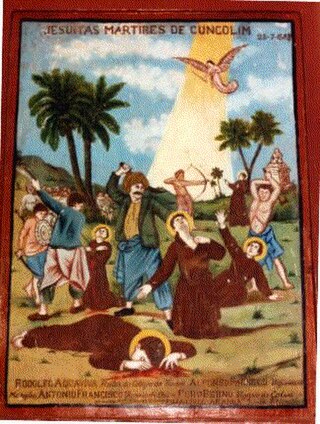
Roman Catholic Kshatriyas are a modern Christianised caste among Goan, Bombay East Indian, Mangalorean, Kudali & Karwari Catholics. They are the patrilineal descendants of Kshatriya and Vaishya Vani converts to the Latin Church, in parts of the Konkan region that were under Portuguese Goan rule. They are known as Chardo in Goan Konkani, Charodi in Canarese Konkani & as Sandori or Vadval in Damanese and Mahraashtrian Konkani, while others also identify as Khatri in the Bombay East Indian dialect. The well known households and well to do individuals among them, have mostly been endogamous.
Jack Copley Winslow, also known by names John Copley Winslow or J.C. Winslow or John C. Winslow or Jack C. Winslow, was an English Society for the Propagation of the Gospel (SPG) missionary to Konkan and Pune, then-Poona—both part of then-Bombay Presidency. He was an evangelist, hymnist, and the founder of Christa Seva Sangh—interpreted as Community of the Servants of Christ or The Fellowship of the Servants of Christ and/or The Christian Fellowship of Service.
Religion in Maharashtra is characterised by the diversity of religious beliefs and practices.
The East Indian language or East Indian dialect, also known as Mobai Mahratti and East Indian Marathi, is the form of Marathi-Konkani languages spoken in Bombay (Mumbai). It has a significant amount of Indo-Portuguese loanwords. It does not have a unique script of its own: Devanagari and the Roman script are used by most of its speakers, who are the native Christians of the Seven Islands of Bombay in the northern Konkan division. Though the dialect is losing popular usage due to immigration, depopulation & Anglo-Americanisation among most of the younger generation. It is still used by some for songs and dramas, as well as in Christian worship since the Novus Ordo was approved in the 1960s.


